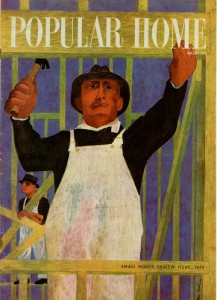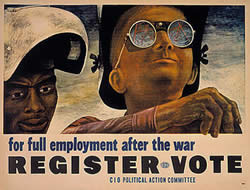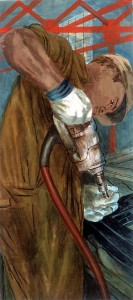 Ben Shahn (1898-1969)
Ben Shahn (1898-1969)
Carpenter
Cover illustration for Popular Home (Late Spring 1949, Small Homes Review Issue)
Isn’t illustration about communication? Isn’t its function to transmit ideas or to create images that represent the content of the book or magazine, or to picture an idea or a point of view? The visual impact of a great cover illustration may draw readers to pick up a magazine at the newsstand—a concept that the publishers of magazines like The Saturday Evening Post exploited with great success.
We may not think of the American artist Ben Shahn as an exceptional illustrator with amazing skills, but when I stumbled across the above pictured cover for a fourteen page 1949 pamphlet featuring house plans and advertisements for US Gypsum products*, I was struck by the strength and appropriateness of Shahn’s illustration. In the foreground a carpenter holds a horizontal board in his left hand as he hammers with his right hand. Although there is a image of a horizontal board in the space below his waist that also serves for the placement of the issue’s title and date block, it is the larger overhead board, marked with the magazine’s name, that appears as though it will serve as the constructed header for a window that, when the house is complete, will eventually be looked into and out of in this residence.
What is most compelling about this illustration is the figure of the carpenter at work in the foreground of the picture space. What captured my attention first in this figure were the colors lurking below the surface of the painted white overalls. Shahn’s painting technique entailed the layering up of thin colors that seem to bleed through to the surface of the image. In the case of this illustration the apparent thinness of the white carpenter’s coveralls hints at the long under ware (a body-covering red union suit) worn next to the skin to help working men keep warm in the chill of the day. Reinforcing this perception we see this workman layered a black sweater over the shirt and both are pulled down to the man’s wrists. The carpenter in the background wears a similar combination of clothing, but his sleeves are pushed up to his elbow, indicating that he is less cold that the foreground worker. Both carpenters wear brimmed hats, not only to help keep the sun out of their eyes, but to hold in their head heat.
I am entranced by the largeness of the foreground carpenter’s hands. In part their over-largeness is an element of Shahn’s foreshortening of the arms to imply that the body is further back in the picture space. Those hands also reinforce the topic of the image—men building homes. I am also drawn to the carpenter’s stolid face. Focused on the work in-hand (literally and figuratively) he is oblivious to being watched, allowing us who look at the illustration to stare without concern.
Ben Shahn was obviously able to communicate and convey meaning in his pictures and illustrations. In addition to producing memorable political images for posters and placards, Ben Shahn also illustrated covers for Fortune, Time, and Harper’s magazines; during the Depression Shahn worked as a photographer for the Farm Security Administration; he produced posters for the Office of War Information during WWII; and worked as a commercial artist for CBS. He took commissions for illustrations and graphic design work only if he felt the intended image was of personal or social value.
Ben Shahn (1898-1969)
The Riveter (mural study for Bronx, New York central postal station), 1938
In the 1930s, Shahn and his second wife, Bernarda Bryson Shahn, were commissioned by the United States Post Office to create a set of thirteen murals inspired by Walt Whitman’s poem, “I Hear America Singing.”**
“I hear America singing, the varied carols I hear,
Those of mechanics, each one singing his as it should be blithe and strong,
The carpenter singing his as he measures his plank or beam, . . . .”
These murals were completed in August 1939 and were installed at the Bronx Central Annex post office building. As we see in the above study, The Riveter is an iconic American working man helping to create something new by the efforts of his hands.
Many of Shahn’s illustrations and public mural work focus on the working, constructing man. During WWII, one of Shahn’s most memorable posters (see below) was focused on aiding the cause of anti-discrimination in the shipyards by picturing a black man and a white man working side by side as welders.
 Ben Shahn (1898-1969)
Ben Shahn (1898-1969)
For Full Employment after the War, Register-Vote, 1944
The Museum of Modern Art, New York
Equally important in Shahn’s illustrations of American life, were those that urged America’s working men to organize and support their right to earn a decent living from the efforts of their hands. Ben Shahn seems to have been saying over and over again, the future of America is in the hands of it’s workers.
* These are color advertisements touting US Gypsum’s Sheetrock and Texolite paint from United States Gypsum inChicago.
** Bryna Shahn mistakenly called the Whitman poem, “See America Working.”
*** Unfortunately, the United States Postal Service is currently considering selling this post office building which is also an official city landmark of the Bronx. The proposal was sent to the Bronxborough president in January of 2013. See, https://cityroom.blogs.nytimes.com/2013/02/01/postal-service-considers-sale-of-bronx-general-post-office/?emc=eta1 “Postal Service Considers Sale of Bronx General Post Office by David W. Dunlap in The New York Times (February 6, 2013).
April 4, 2013
By Joyce K. Schiller, Curator, Rockwell Center for American Visual Studies, Norman Rockwell Museum







